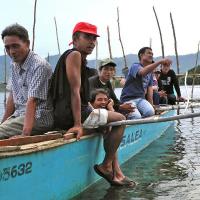Common Murre
Common murres typically spend their winters close to their breeding grounds, often alongside other nesting birds including Atlantic puffins and storm petrels. They make their homes on cliffs or rocky ledges, and unlike most birds they do not make nests. Instead they lay their pear-shaped eggs directly on the bare rock.3 Both parents help incubate the egg, … Read more



